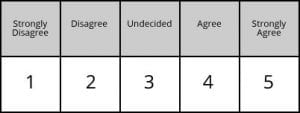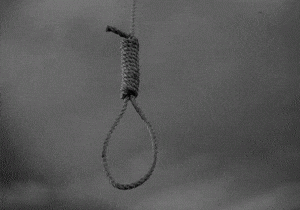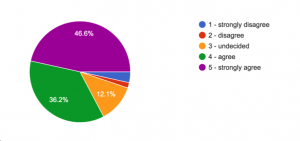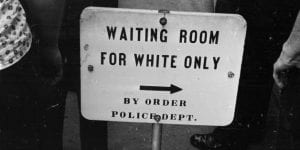Introduction:
Originally, I conducted a research project that revolved around the question, how does the United States today justify the death penalty? Through exploring arguments that both supported and opposed implementing capital punishment, I then began to question who typically throughout various centuries of social conditioning most commonly find themselves on death row.
Through my previous findings, one of my sources conducted a study in which the authors questioned how aware students on campus were about the death penalty and what contributes towards individuals being placed on death row. At the end of their study, the authors invited and encouraged university students to conduct the same study. Two of these questions asked participants whether or not they believed minorities and those from poverty most frequently represent the population of people who end up on death row.
After viewing the responses from my survey, I then began to wonder if people’s assumptions on who routinely are sentenced to death by the state are correct. Through conducting my own research study and reviewing my original sources, I was able to draw new connections that tied all my findings together. This overall is what lead me to my new research question, why are minorities and people from poverty most frequently found on death row?
Methodology:
For my first project assessing the rationale behind supporting or opposing capital punishment, my main method of research was conducted through a questionnaire, specifically, an online Likert scale. After making my research project public, I asked for various individuals to participate, rating if they either strongly agreed, agreed, were neutral, disagreed, or strongly disagreed with fourteen statements. Once again, this method was motivated by one of my primary articles used for research, in which the authors enthusiastically invited and encouraged college students to conduct the same study.
This form of research instrument allowed for various individuals to take part in my study with no difficulty at a relatively quick speed. By locating the survey online and circulating it through the online social media platform, reddit, the overall amount of bias was diminished. Ultimately, it then became easier to draw inferences from after gathering data and comparing results.
I then went on to review past sources for missed information and pursue online information to answer my new research question. The majority of this process meant researching background information and evidence to display relevance today. Through scouring the internet for new sources I was then able to find several linking factors that connect previous and new research.
Background:
The main reason people from Africa were brought to the United States through the Columbian Trade System was for the sole purpose of being imprisoned and to be used as property by white men. The Colombian Trade system was the first trading system from when Christopher Columbus founded the New World and acted as a major turning point in the development of human history. Not only were cultures, technologies, diseases, plants, and animals transferred between the Old and New Worlds, but human populations who were then enslaved by the white man.
Despite years of change in law and social structure that allowed for Africans to be considered African Americans, racism remains the base of American economics and contributes to the way prison systems are run. While enslavement still exists, slavery within the United States has taken on a new meaning. “Slave” labor is enforced in jails as inmates are required to work intense conditions, yet are paid such a minimal amount that their profits can be argued as nothing.
For those who end up in jail, larger populations represent black males and those from less financially fit backgrounds. The primary reason for these results reflects both surface level racism and deep-rooted racism. Holding on to such core values lead to embedded beliefs and subtle acts of prejudice. People are exposed to the role of prejudice in everyday life through the culture that has grasped a deathly hold onto core values and customs. As depicted in real-world experiences of acts of discrimination and hatred to literature and media through novels and film, it is impossible to escape the ways society has allowed inequity to remain prevalent.
Such deeply-rooted ideas are still implemented in the way our laws are structured. The intensity of biases created against black men leads to a false narrative through all levels of crime. Jessica Luther, in the novel Unsportsmanlike Conduct: College Football and the Politics of Rape, history’s labeling of “black men as the natural rapist (Luther, 68).” In cases that were untrue, once no longer a slave white women often went on to say that black men had raped. These false accusations through time have left a stain on social biases, as African American men are most commonly charged with rape.
“Nearly 90% of those executed for rape since 1930 were black” (Gross, 13).
If black men are capable of fulfilling the role of the “natural rapist,” questioned by much of society are what else he is capable of. Where in comparison, the white man is considered to have only “made a mistake” and is “still learning right from wrong.”
It was through this form of thinking that society took “common slavery,” and replaced it with “everyday lynching.” In an act of racism, people were willing to reach any form of conclusion that would ultimately lead to the death of black individuals. This is one of America’s first examples of the death penalty for “free individuals,” without actually being classified as state-sanctioned murder.
On top of those found in jail systems within the United States, the number of individuals who have been executed is disproportionately black. Such findings reference to evidence from the Civil War, where the difference been amount of executions between black individuals and white individuals reflect as being significantly unbalanced. In terms of developing evidence when the law officially allowed for the state to declare murder, figures remain only available for up to the past half-century
“Before the Civil War several southern states had statutes that explicitly discriminated against blacks by making some types of conduct punishable by death only if the defendant was black, or the victim was white or both” (Gross, 13).
Few of the strongest correlations between those incarcerated and put to death are gender, race, poverty, and location of upbringing. In regards to research and social depictions, black people are viewed as coming from poverty while white people are presented as having different opportunities that stem from wealth.
Findings:
Through my primary measurement of research, I asked individuals to participate in an online Likert scale where they responded to fourteen questions. When responding to the statement, “The poor are most likely to receive the death penalty,” 40.7% strongly agreed, 25.4% agreed, 22% were undecided and 11.9% of responses disagreed, and nobody strongly disagreed with the statement. When asked to respond to the statement, “Minorities are more likely to receive the death penalty,” 46.6% strongly agreed, 36.2% agreed, 12.1% were undecided, 1.7% disagreed, and 3.4% strongly disagreed.
As conducted through online research, those more likely to be placed on a death sentence are those of color and coming from poverty. Specifically, found across the states, the majority of capital punishment cases have been found to be discriminatory against people who are poor, powerless, and black.
“those accused of murdering whites are more likely to be sentenced to death than those accused of murdering blacks. This trend is due primarily to the higher probability for those accused of murdering whites to be indicted for first-degree murder” (Radelet, 1).
Other factors identified for contributing towards committing crimes that place an individual on death row or in prison are coming from unemployment, poverty, homelessness, suffering from alcohol addiction, drug addiction, or physical and sexual abuse. White racism remains a prevalent issue as those in support of the death penalty are most commonly white people, specifically white males. Which also introduces how gender is an also contributor towards those who support the death penalty.
“Before the Civil War several southern states had statutes that explicitly discriminated against blacks by making some types of conduct punishable by death only if the defendant was black, or the victim was white, or both” (Gross, 13).
Discussion:
Despite years of change, everyday acts of racism continue to be one of the United State’s largest social problems. Become almost “normalized,” as commonly reported in media include acts of hate crimes and outright violence. Such brutality is demonstrated in police shootings, as stereotypes and assumptions shaped by centuries of oppression and segregation continue to be found in today’s working society.
Such laws that permit the U.S to justify the death penalty primarily attack people of color and those categorized as coming from less financially fit backgrounds. This contributes to the notion that times have not changed despite such claims being made. State-sanctioned deaths and imprisonment still target individuals who have started from non-white and lower-income backgrounds to be murdered by justifications supported by deep social conditioning. Not only does this reflect human error by allowing people of color and those from harsher backgrounds to be imprisoned in the first place, but how deeply rooted racism is intertwined with America’s economic systems.
Individual acts of racism such as hate crimes and police shootings are merely outcomes from an overall system that allows the death of people due to their background and upbringings. These deep-rooted values engrained within our systems permit discrimination to continue.
As reflected in the results from my survey, despite recognizing these unjust ways of thinking, instead of acting to create change, people accept such prejudice as a universal truth.
Conclusion:
Labels tied to core values of slavery and discrimination have resulted in a brutal and violent path for black individuals. Despite being aware of the unjust nature to assume the worst of race and people of little or no income, nothing is being done to correct such false assumptions made. Racism and discrimination remain deeply rooted within our society and engrained in the way American prison systems are run. Through racial and economic bias, those most typically arrested or placed on death row are people of color and those in poverty.
For More Information:
As white privilege was only mentioned briefly and still plays a large role in racial bias, check out Dr. Robin DiAngelo’s discussion of white privilege and the impact it has on day to day life.
References:
Baldwin, John. “Culture, Prejudice, Racism, and Discrimination.” Oxford Research Encyclopedia of Communication, 18 Apr. 2018, oxfordre.com/communication/view/10.1093/acrefore/9780190228613.001 .0001/acrefore-9780190228613-e-164.
Blume, John, et al. “Explaining Death Row’s Population and Racial Composition.” The Canadian Journal of Chemical Engineering, Wiley-Blackwell, 1 Dec. 2003, onlinelibrary .wiley.com/doi/full/10.1111/j.1740-1461.2004.00006.x.
“The Columbian Exchange.” Khan Academy, www.khanacademy.org/humanities/us-history/precontact-and-early-colonial-era/old-and-new-worlds-collide/a/the-columbian-exchange-ka.
General Commission on Religion and Race of The UMC. YouTube, YouTube, 21 Feb. 2017, www.youtube.com/watch?v=DwIx3KQer54.
Gilmore, Kim. “Slavery and Prison — Understanding the Connections.” Social Justice, vol. 27,205.3(81), 2000, pp. 195–205. JSTOR, www.jstor.org/stable/29767242.
Gross, Samuel R., and Robert Mauro. “Patterns of Death: An Analysis of Racial Disparities in Capital Sentencing and Homicide Victimization.” HeinOnline, Board of the Trustees of the Leland Stanford Junior University,heinonline.org/HOL/Page?collection=journals&ha ndle=hein.journals/stflr37&id=61&men_tab=srchresults.
Jordan, I King. “The Columbian Exchange as a Source of Adaptive Introgression in Human Populations.” Biology Direct, BioMed Central, 2 Apr. 2016, www.ncbi.nlm.nih.go v/pmc/ articles/PMC4818900/.
“Likert Scale Survey Temple.” Perfect Resume Example Resume And CV Letter, resumehcsqn.netlib.re/like rt-scale-survey-template.html.
Luther, Jessica. Unsportsmanlike Conduct: College Football and the Politics of Rape. Akashic Books, 2016.
MSNBC. 1 In 10 Still Support Discrimination Against African-Americans On Religious Grounds. 6 June 2014, www.huffingtonpost.com/2014/06/06/discrimination-african-americans_n_5462036.html.
Racklin, Meghan. “Why Mandatory Minimum Sentencing For Sexual Assault Isn’t The Answer.” The Establishment, 21 July 2016, medium.com/the-establishment/why-mandatory-minimum-sentencing-for-sexual-assault-isnt-the-answer-266839160e6c.
Radelet, M L. “PUBLICATIONS.” NCJRS Abstract – National Criminal Justice Reference Service, Edna McConnell Clark Foundation New York, NY 10177 NAACP Legal Defense and Educational Fund, Inc Washington, DC 20005 North Shore Unitarian Veatch Program, www.ncjrs.gov/App/Publications/abstract.aspx?ID=80800.
Tyler, Keegan C. “Google Forms – Create and Analyze Surveys, for Free.” Google Docs, Google, 15 Feb. 2019, docs.google.com/forms/d/1DQWSZvE2aqV4yu0DOb8v6wsGGL0 SodP-Ya4n_sR-Tlo/prefill.
Sethuraju, Raj, et al. “Understanding Death Penalty Support and Opposition Among Criminal Justice and Law Enforcement Students.” SAGE Open, vol. 6, no. 1, 2016, pp. 1–15., doi:10.1177/2158244015624952.
Wise, Jenna. “Man Sues Westmoreland County Prison after Fight Leads to ‘Severe Beating,” Injuries.” Pittsburgh Post-Gazette, 19 July 2018, www.post-gazette.com/news/crime-courts/2018/07/19/Jordan-Yonkers-Westmoreland-County-Prison-warden-corrections-officers-Christopher-Smarr/stories/201807190195.
Zaveri, Mihir. “Senate Unanimously Passes Bill Making Lynching a Federal Crime.” From The G-Man, fromthegman.blogspot.com/2018/12/senate-unanimously-passes-bill-making.html.







